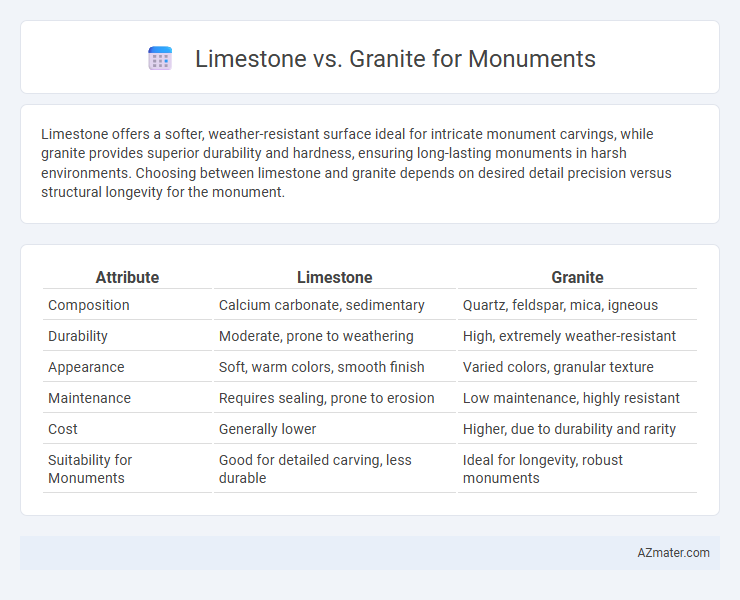Limestone offers a softer, weather-resistant surface ideal for intricate monument carvings, while granite provides superior durability and hardness, ensuring long-lasting monuments in harsh environments. Choosing between limestone and granite depends on desired detail precision versus structural longevity for the monument.
Table of Comparison
| Attribute | Limestone | Granite |
|---|---|---|
| Composition | Calcium carbonate, sedimentary | Quartz, feldspar, mica, igneous |
| Durability | Moderate, prone to weathering | High, extremely weather-resistant |
| Appearance | Soft, warm colors, smooth finish | Varied colors, granular texture |
| Maintenance | Requires sealing, prone to erosion | Low maintenance, highly resistant |
| Cost | Generally lower | Higher, due to durability and rarity |
| Suitability for Monuments | Good for detailed carving, less durable | Ideal for longevity, robust monuments |
Introduction to Limestone and Granite Monuments
Limestone and granite are popular choices for monuments due to their durability and aesthetic appeal. Limestone, a sedimentary rock composed mainly of calcium carbonate, offers a softer texture ideal for intricate carvings and a natural, weathered look. Granite, an igneous rock rich in quartz and feldspar, provides exceptional hardness and resistance to weathering, making it suitable for long-lasting outdoor monuments.
Geological Origins: Limestone vs Granite
Limestone forms primarily from the accumulation of marine organisms' skeletal fragments, such as coral and shell, resulting in a sedimentary rock rich in calcium carbonate. Granite is an intrusive igneous rock composed mainly of quartz, feldspar, and mica, crystallized slowly beneath the Earth's surface from molten magma. The geological origins influence durability and appearance, with granite generally exhibiting greater hardness and weather resistance compared to the more porous and softer limestone.
Appearance and Aesthetic Differences
Limestone exhibits a soft, muted appearance with natural, earthy tones often ranging from creamy white to light gray, creating a warm and timeless aesthetic for monuments. Granite features a more polished, durable surface with speckled textures and a wide color palette including black, pink, and green, offering a bold and elegant visual impact. The choice between limestone and granite for monuments depends on the desired look, where limestone suits classic, understated designs, and granite supports vibrant, high-contrast statements.
Durability and Weather Resistance
Granite exhibits superior durability and weather resistance compared to limestone, making it a preferred choice for monuments exposed to harsh environmental conditions. Limestone is more susceptible to erosion and acid rain damage due to its softer calcium carbonate composition, which compromises its longevity. Granite's dense, igneous structure provides excellent resistance to weathering and maintains its structural integrity and aesthetic appeal over centuries.
Maintenance and Longevity Comparison
Limestone monuments require more frequent maintenance due to their porous nature, which makes them susceptible to weathering, erosion, and biological growth, resulting in potential surface damage over time. Granite monuments offer superior longevity, characterized by high resistance to scratches, stains, and environmental elements, which minimizes the need for regular upkeep and preserves inscriptions clearly for decades. Choosing granite ensures a lower lifetime maintenance cost and sustained aesthetic appeal compared to limestone in monument applications.
Carving Detail and Customization
Limestone offers superior ease of carving detail due to its softer, fine-grained texture, enabling intricate designs and delicate engravings ideal for customized monuments. Granite's hardness and durability make it less suitable for elaborate carving but provide exceptional weather resistance, preserving simpler motifs over time. Choosing between limestone and granite depends on whether intricate customization or long-lasting resilience is the priority for the monument.
Cost Considerations
Limestone generally offers a lower cost option compared to granite due to its abundant availability and easier quarrying process. Granite's higher price stems from its durability, density, and the labor-intensive cutting and polishing required to achieve a refined finish. When budgeting for a monument, limestone can be cost-effective for shorter-term projects, while granite's longevity may provide better value for long-term memorials.
Environmental Impact and Sustainability
Limestone exhibits lower embodied energy and carbon footprint compared to granite, making it a more environmentally sustainable choice for monuments. Its natural abundance and biodegradability reduce long-term ecological damage, while granite mining and processing typically consume more energy and result in higher emissions. Selecting limestone supports reduced environmental impact without compromising durability, essential for monument preservation.
Popular Uses in Monuments and Memorials
Granite is popular for monuments and memorials due to its exceptional durability, resistance to weathering, and ability to retain polished surfaces over time, making it ideal for outdoor sculptures and gravestones. Limestone, favored for its softer texture and ease of carving, is commonly used in historic monuments and intricate architectural details, offering a classic aesthetic that weathers to a natural patina. Both materials serve significant roles in commemorative art, with granite chosen for longevity and limestone for artistic expression.
Choosing the Right Stone for Your Monument
Choosing the right stone for your monument involves evaluating the durability and aesthetic qualities of limestone and granite. Granite offers superior resistance to weathering and erosion, making it ideal for outdoor monuments that require longevity and minimal maintenance. Limestone provides a classic, softer appearance with ease of carving but may be more prone to surface wear over time, suitable for indoor or less exposed memorials.

Infographic: Limestone vs Granite for Monument
 azmater.com
azmater.com